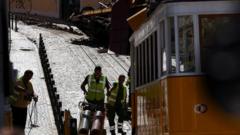What Failures Led to the Lisbon Funicular Crash?

Published: 2025-10-20 21:00:19 | Category: technology
A preliminary investigation into the tragic funicular crash in Lisbon that claimed 16 lives, including three British nationals, has revealed significant safety oversights. The report highlights a defective underground cable, acquired by the transport company Carris, which was not certified for passenger use. The Glória funicular, a historic transport link, derailed and crashed into a building, leading to multiple fatalities and injuries.
Last updated: 12 October 2023 (BST)
Key Takeaways
- A defective cable was responsible for the crash of the Glória funicular.
- There was a lack of oversight and testing by Carris prior to the accident.
- Lisbon's mayor emphasised that technical failures, not political ones, caused the tragedy.
- The full investigation report will take around 11 months to complete.
- All cable cars in Lisbon have been suspended pending safety checks.
The Lisbon Funicular Crash: An Overview
The tragic incident occurred on 3 September 2023 when the Glória funicular derailed and crashed into a building in the heart of Lisbon. This popular tourist attraction, which has been in operation for over 140 years, became the site of devastation, leading to the loss of 16 lives, including three British citizens.
What Happened During the Incident?
Eyewitness accounts describe a chaotic scene as the funicular, known for its steep ascent, suddenly lost control. The underground cable, which functions as a counterweight for the two carriages, reportedly snapped, leading to the crash. Despite the driver's attempt to engage the emergency brake, the system failed to operate effectively, contributing to the severity of the incident.
Investigative Findings: Safety Oversights
The preliminary report by Portugal's Air and Rail Accident Investigations Bureau has raised serious concerns regarding the safety protocols surrounding the Glória funicular. Key findings include:
Defective Cable
The cable that broke during the incident was deemed defective. It had never been certified for passenger transportation and was not technically suitable for use. Carris, the operator of Lisbon's public transport system, acquired the cable in 2022 without proper oversight.
Lack of Proper Oversight
Investigators found that Carris had failed to conduct necessary inspections and testing before installing the cable. Furthermore, the company responsible for the supervision and maintenance of the funicular reportedly provided an all-clear signal on the day of the crash, although it remains unclear if an actual inspection took place.
Emergency Brake System Failure
The report also highlighted that the emergency brake system, which the driver attempted to activate during the incident, was not functioning correctly. This critical safety mechanism had not been tested prior to the crash, raising questions about the overall maintenance of the funicular.
Political Reactions and Accountability
In the aftermath of the crash, Lisbon's mayor, Carlos Moedas, reiterated to the press that the tragedy stemmed from technical rather than political failings. He faced criticism regarding his oversight of the city's funiculars, particularly after the report's findings. Despite this, he was re-elected on 12 October 2023.
Carris' Statement
In response to the report, Carris issued a statement asserting that it is too soon to determine whether the non-compliance of the cable contributed to the accident. They noted that the cables had been operational for 601 days without incident prior to the crash, suggesting that other factors may have influenced the cable's failure.
What Happens Next?
The final investigation report is expected to take approximately 11 months to complete. In the meantime, all cable cars in Lisbon have been ordered to cease operations until comprehensive safety checks can be implemented. This decision is aimed at preventing further tragedies and ensuring the safety of both residents and tourists.
Long-Term Implications for Lisbon's Transport System
This incident raises significant concerns regarding the safety standards of public transport in Lisbon. The findings could lead to policy changes and stricter regulations surrounding the maintenance and operation of funicular systems across the country. The impact on tourism, particularly in the wake of such a tragedy, may also influence future infrastructure investments and public confidence in transport safety.
Conclusion
The Glória funicular crash is a stark reminder of the importance of stringent safety protocols in public transport systems. As the investigation unfolds, it is crucial for authorities to prioritise the implementation of necessary changes to prevent future tragedies. The loss of lives in such an incident cannot be overlooked, and the focus must shift towards safeguarding the public. What lessons will be learned to ensure such a disaster never occurs again?
#LisbonCrash #PublicTransportSafety #FunicularInvestigation
FAQs
What caused the funicular crash in Lisbon?
The crash was caused by a defective underground cable that broke, leading to the funicular derailing and crashing into a building. The cable had not been certified for passenger use.
How many people died in the Lisbon funicular crash?
Sixteen people lost their lives in the crash, including three British nationals. An additional 20 individuals were injured during the incident.
What has been done following the incident?
In the aftermath, all cable cars in Lisbon have been ordered to cease operations until safety checks are conducted. A full investigation report is expected to be completed in approximately 11 months.
Who is responsible for the safety of the funiculars?
The operator of Lisbon's public transport, Carris, is primarily responsible for the maintenance and safety of the funiculars. However, oversight and testing protocols have been called into question following the crash.
What are the implications of the crash for Lisbon's transport system?
The crash may prompt changes in safety regulations and oversight for public transport systems in Lisbon. It underscores the need for rigorous maintenance and inspection protocols to prevent future incidents.



